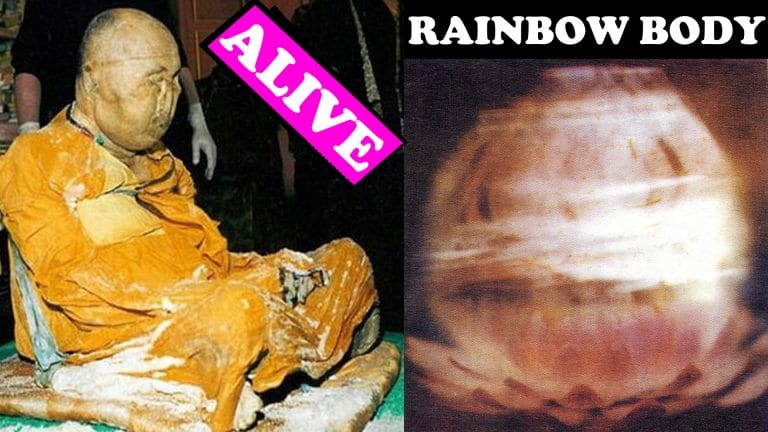
Buddhist Monks Superpowers: Rainbow Body, Levitation, Immortal Monks
Mysterious Abilities of Buddhist Monks.
Over 700 years ago, famed explorer Marco Polo reached the furthest limits of his legendary journey from West to East, arriving in Tibet, more than 4000 miles from his home. There, he became the first Westerner to record an encounter with Tibetan lamas, Buddhist monks hidden away in the Himalayan Mountains. In the seminal work about his journey, The Travels of Marco Polo, he describes how these monks were able to levitate off the ground. Of course, Marco Polo was not alone in this type of observation. Over the centuries, many have recorded instances of Buddhist masters who could levitate. Even in modern times, videos have surfaced, which appeared to show exactly that. Levitation, incidentally, is one of four psychic powers mentioned within Buddhist scriptures, alongside telepathy, psychokinesis, and the ability to divide the astral body from the physical body. The Buddha himself was said to possess “all manner of supernatural powers,” including the ability to levitate and to know the thoughts of others, to create doubles of himself, and even to project fire and water from his body.
Records of The Powers of Monks
Think of modern viral videos of monks walking over hot coals, running on top of water, being stabbed but not pierced by sharp objects, or meditating in boiling oil. Remember back to 1963, when one of the most famous photographs of all time was taken in South Vietnam, as a Buddhist monk protesting the Vietnam War lit himself on fire and sat meditating, without moving, without making so much as a sound, as he burned to death. Consider the words of Swami Rama in his 1978 classic, Living with the Himalayan Masters:“I had never before seen a man who could sit still without blinking his eyelids for eight to ten hours, but this adept was very unusual. He levitated two and a half feet during his meditations. We measured this with a string, which was later measured by a foot rule. He had the power to transform matter into different forms, like changing a rock into a sugar cube. One after another the next morning he did many such things. He told me to touch the sand – and the grains of sand turned into almonds and cashews.”Incredible accounts such as these beg a crucial question: Are monks some kind of superhumans? Or have they merely mastered teachings and techniques available to anyone.
Transcending the Physical Body
In the early 1980s, the head of the Kagyu lineage of Tibetan Buddhism, known as the ‘Karmapa,’ began to travel the world, spreading his teachings and giving interviews. He carried with him similar importance to the Dalai Lama, the head of the Gelugpa lineage of Tibetan Buddhism. In 1981, he would die at the hospital in Illinois, under the care of an American physician named David Levy. The account of his death, given by Dr. Levy, was something unbelievable. 45 minutes after the Karmapa’s heart had apparently failed, “we began to pull out the tubing, but I suddenly saw his blood pressure was 140 over 80. A nurse screamed, “he has a good pulse!’ […] It was clearly the greatest miracle I had ever seen.” 48 hours later, Levy noted,“If I moved my hands towards the side of his chest, the body was cold, but the area around the heart stayed warm.”Further, there was no odor or decay, as usually is the case after death. Over a decade later, a Catholic priest from the United States named Father Francis Tiso traveled to Tibet, determined to look into the strange happenings taking place after the deaths of monks like the Karmapa and others. There, Tiso documented the extraordinary case of Khenpo Achö and his death in 1998. As the local press reported:
“Recently, on August 29, 1998, at Dome Khamngak in Azi Rong in Tibet, Khenpo Achö, eighty years of age, attained physical dissolution. One day at noon, lying in bed, without having suffered any recent illness, while in the posture of a sleeping lion and reciting the six-syllable mantra, he attained Buddha in the primordial basic matrix of alpha-purity, his heart of clear light reality perfected beyond the intellect. As his body dissolved into light, his wrinkles vanishing, he seemed like an eight-year-old child with a beautiful complexion. […] His body gradually diminished in size, and at the end, he attained Buddha; not even his nails and hair were left behind. It was just like a bird flying from a rock— people nearby have no idea where it might have gone.”In other words, Acho didn’t so much die, as he just disappeared.
The Rainbow Body
This was an example of the ancient phenomenon known as the “Rainbow Body,” the realization of the Buddhist teaching of ‘Dzogchen.’
Author Michael Sheehy describes the ideology:“In Dzogchen cosmology, the cosmos is envisioned as being utterly open and translucent. Movement ensues when the element of air stirs up wind that oscillates rapidly into fire; from fire emerges water, and from water, the solidity of rock and earth are stabilized. With this gravitational collapse into the elemental forces that comprise the cosmos, a spiraling reconfigure matter into worlds wherein embodied beings form.”In other words, everything in the universe, including humans, is pure light in perpetual motion, collapsed into “the elemental forces that comprise the cosmos” – water, fire, rock, and so on. Sheehy continues:
“Under certain circumstances, the cosmic evolutionary process of matter’s gravitational collapse into solidity can turn itself back into a swirling radiating configuration.”This means that successful Dzogchen practitioners, like Khenpo Acho, can, in effect, reverse the process of collapse, returning the dense matter of their bodies to a state of pure light – the ‘Rainbow Body.’ Curiously, this is a concept that appears across many of the world’s spiritual traditions. In Taoism, it is referred to as “the diamond body,” while Hindus call it “the divine body;” in Islamic mysticism, it is called “the most sacred body,” while ancient alchemical traditions called it “the golden body.” In fact, in both Jewish and Christian traditions, as well as the ancient texts of Greece and Egypt, there are stories of death via ascension, perhaps a metaphor for the Rainbow Body. Since we mentioned the mysterious death of the 12th Karmapa, take a look at this photo of him, during the Black Crown Ceremony in which he also achieved the Rainbow body, appearing almost transparent in the photo.
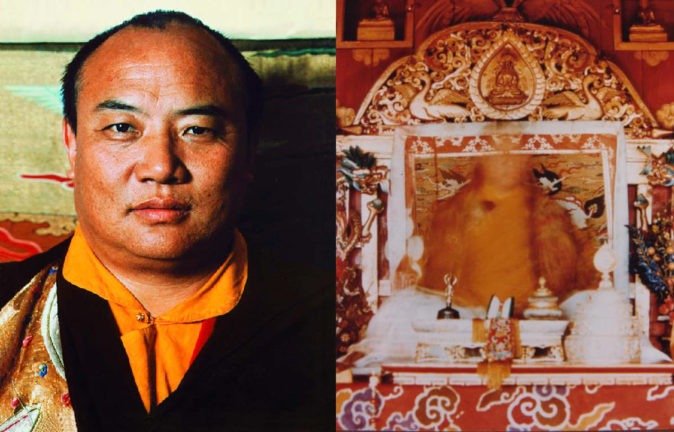 Yet, there can be no doubt, something unusual is going on in the Himalayan Mountains. In fact, in Tibet and India alone, there have been over 160,000 documented cases of people turning their physical bodies into pure light. But this is not something only from the past; rather, it continues to this day. Only a few years ago, prominent Tibetan Buddhist, Dzogchen Khenpo Choga Rinpoche, recorded the death of his teacher as such:
Yet, there can be no doubt, something unusual is going on in the Himalayan Mountains. In fact, in Tibet and India alone, there have been over 160,000 documented cases of people turning their physical bodies into pure light. But this is not something only from the past; rather, it continues to this day. Only a few years ago, prominent Tibetan Buddhist, Dzogchen Khenpo Choga Rinpoche, recorded the death of his teacher as such:
“My precious teacher, Lama Karma Rinpoche, has passed. I received the extraordinary news from my friends in Tibet that the sacred body of my kind teacher has dramatically shrunk in size. Lama Karma was about 5’9″ tall, but two weeks after he passed, his seated body has now shrunk to about 8″, which means his body, including his skeleton, shrank nearly 80 percent.”
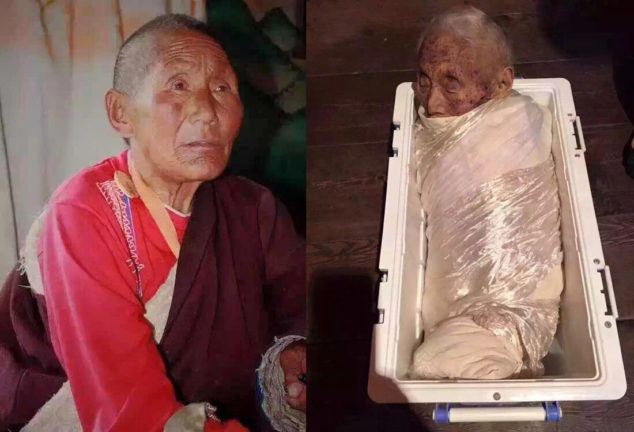
Monks Transcending Death via Ascension
Another fascinating case is the case of lama Dashi-Dorzho Itigilov known as the living dead Buddhist monk. He was born in 1852 and devoted his entire life to spiritual practice. When he was 75, he told other monks that he was ready to die and to begin meditation ceremonies and funeral rites.. He started to meditate on his own, and later the monks also joined him, Itigelov died while meditating.
He left behind a testimonial in which he said that he wanted to be buried in the same position that he was when he died, meditating in a lotus position. In 1955 and 1977, while Dashi-Dorzho Itigilov’s body was being taken out, the monks were astonished to see no signs decay on the body. It was only on September 11, 2002, that his body was finally revealed in front of the members of Buddhist Traditional Sangha. The body was then transferred to Ivolginsky Datsan, a residence of today’s Hambo Lama. The body was examined by scientists, pathologists, and monks. The statement was that: “the body looked like it died only 36 hours ago.” 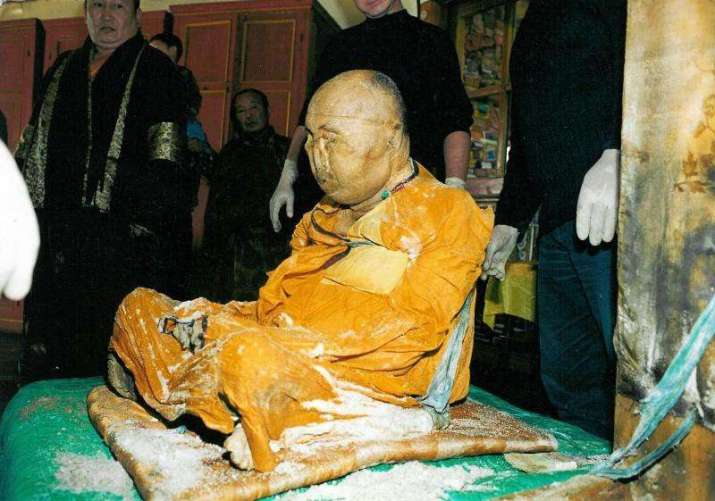 His body was well preserved, with no indications of decay whatsoever, inner tissue and whole muscles intacted, and with skin and soft joints all in place. For two years after the exhumation of Dashi-Dorzho Itigilov’s body, it does not decay nor perish, no fungus, no any other indication that this is the body of a dead man. The Buddhist monks approach him as a living person and shake hands with him. Some Monks even claim that Hambo Lama Itigelov is still alive and is in Nirvana like state. Are accounts like this fantasy? Sleight of hand? Or … science?
His body was well preserved, with no indications of decay whatsoever, inner tissue and whole muscles intacted, and with skin and soft joints all in place. For two years after the exhumation of Dashi-Dorzho Itigilov’s body, it does not decay nor perish, no fungus, no any other indication that this is the body of a dead man. The Buddhist monks approach him as a living person and shake hands with him. Some Monks even claim that Hambo Lama Itigelov is still alive and is in Nirvana like state. Are accounts like this fantasy? Sleight of hand? Or … science?
Monks Manipulating their Body’s Temperature
In the early 1980s, a professor from the prestigious Harvard School of Medicine named Herbert Benson led a team of researchers deep into the Himalayan mountains of Tibet, with the intent of studying the monks at remote Buddhist monasteries, specifically, their alleged ability to manipulate their bodies through a practice called ‘g Tummo’ – the “inner fire meditation.” The results of this study were stunning. As described in Nature magazine in 1982:“In a monastery in northern India, thinly clad Tibetan monks sat quietly in a room where the temperature was a chilly 40 degrees Fahrenheit. Using a yoga technique known as g Tum-mo, they entered a state of deep meditation. Other monks soaked 3-by-6-foot sheets in cold water (49 degrees) and placed them over the meditators’ shoulders. For untrained people, such frigid wrappings would produce uncontrolled shivering. If body temperatures continue to drop under these conditions, death can result. But it was not long before steam began rising from the sheets. As a result of body heat produced by the monks during meditation, the sheets dried in about an hour.”
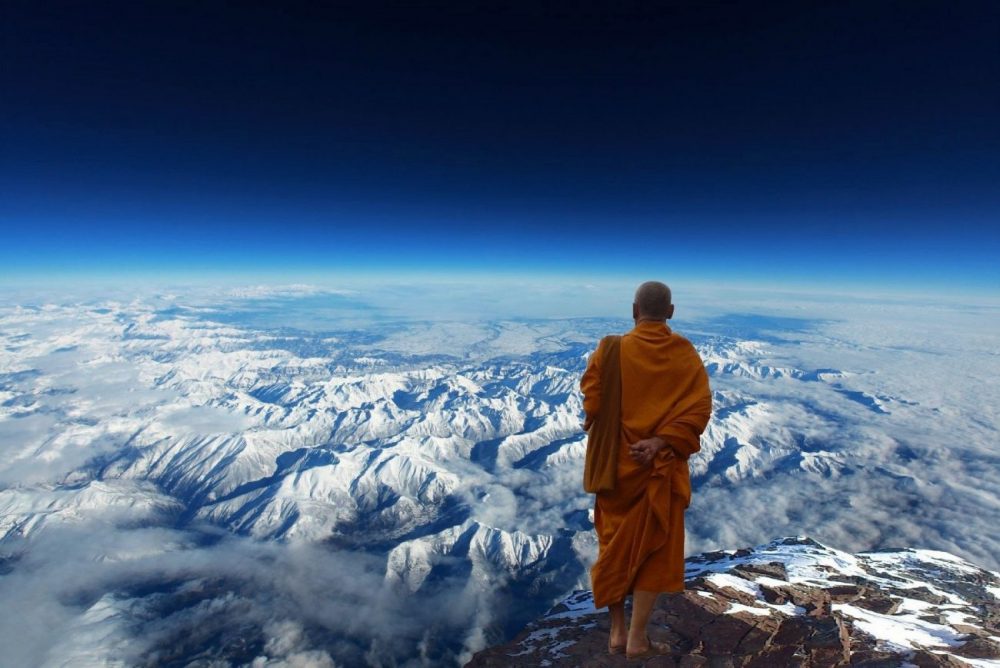 Further, the team documented monks spending freezing nights, when temperatures would drop to zero degrees Fahrenheit, on rocky ledges high in the Himalayans, wearing nothing but cotton shawls. The monks did not huddle together or even shiver, instead, sleeping through the night comfortably. Tangibly, Benson and his team found that the monks could raise the temperature of their fingers and toes by up to 17 degrees using g Tummo. Additionally, they could lower their metabolism during meditation by 64%. For reference, an ordinary person’s metabolism drops about 10-15% during sleep. One man by the name of Wim Hof, spend many years mastering the Buddhist technique of g Tummo. He has set the Guinness world records for swimming under ice and prolonged full-body contact with ice and holds the record for a barefoot half-marathon on ice and snow. Using Tibetan Tummo meditation and pranayama, both of which employ breathing techniques, he created his own method called the Wim Hof Method, which involves cold therapy, breathing, and meditation.
Further, the team documented monks spending freezing nights, when temperatures would drop to zero degrees Fahrenheit, on rocky ledges high in the Himalayans, wearing nothing but cotton shawls. The monks did not huddle together or even shiver, instead, sleeping through the night comfortably. Tangibly, Benson and his team found that the monks could raise the temperature of their fingers and toes by up to 17 degrees using g Tummo. Additionally, they could lower their metabolism during meditation by 64%. For reference, an ordinary person’s metabolism drops about 10-15% during sleep. One man by the name of Wim Hof, spend many years mastering the Buddhist technique of g Tummo. He has set the Guinness world records for swimming under ice and prolonged full-body contact with ice and holds the record for a barefoot half-marathon on ice and snow. Using Tibetan Tummo meditation and pranayama, both of which employ breathing techniques, he created his own method called the Wim Hof Method, which involves cold therapy, breathing, and meditation. 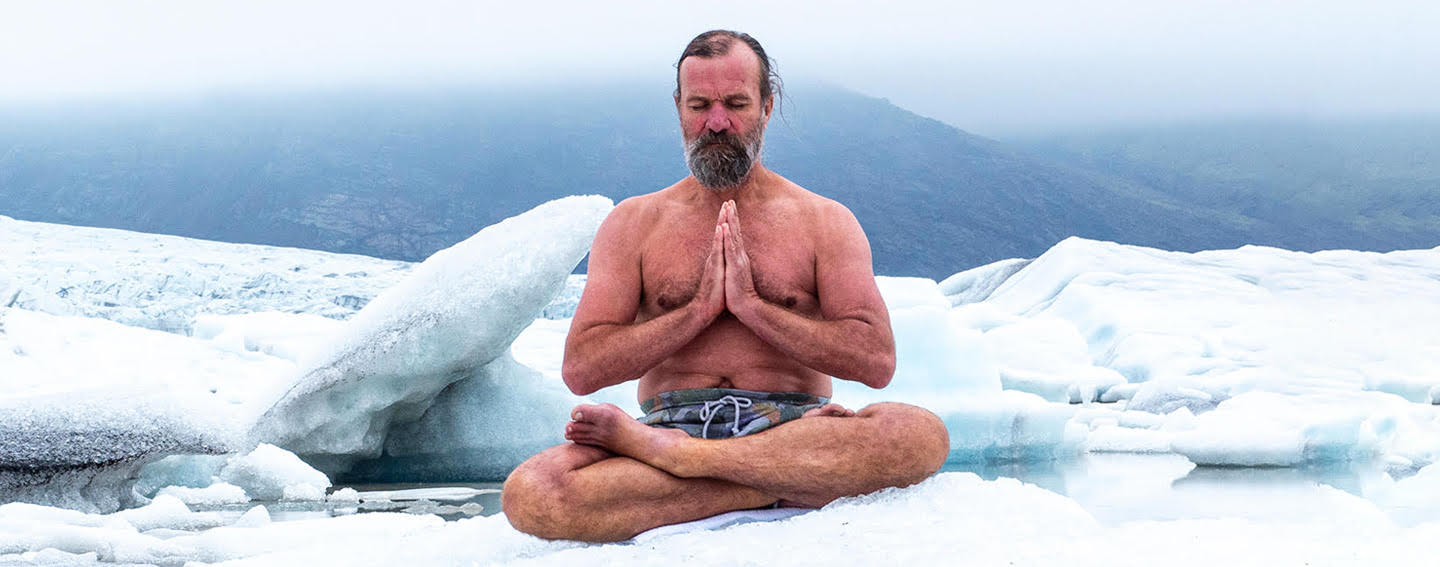 In other words, the monks were able to manipulate the machinations of their bodies – even being able to withstand extreme external stimuli – using their minds.
In other words, the monks were able to manipulate the machinations of their bodies – even being able to withstand extreme external stimuli – using their minds.
The Brain of Buddhist Monks during Meditation
In 2008, a neuroscientist named Richard Davidson conducted research which showed the meditative practices of Tibetan Buddhist monks to dramatically increase neuroplasticity in the brain, that is,“…the brain’s ability to use new experiences or environments to create structural changes, [such as] creating new neural connections.”Astonishingly, the monks had, as Davidson wrote, “altered the structure and function of their brains.” The overlap is interesting. When neuroscience speaks of the shifting networks and circuits in the brain, they support the concept of the ever-changing self, the Buddhist teaching that a stable, rooted “you” is an illusion. A few years later, in 2011, a New York University professor named Zoran Josipovic took the scientific study of monks further, using an MRI machine to track the blood flow to the monks’ brains while they meditated. As Josipovic told the BBC:
“The brain appears to be organized into two networks: the extrinsic network and the intrinsic, or default, network. The extrinsic portion of the brain becomes active when individuals are focused on external tasks, like playing sports or pouring a cup of coffee. The default network churns when people reflect on matters that involve themselves and their emotions. But the networks are rarely fully active at the same time. And like a seesaw, when one rises, the other one dips down.”Incredibly, the study found:
“Some Buddhist monks and other experienced meditators have the ability to keep both neural networks active at the same time during meditation – that is to say, they have found a way to lift both sides of the seesaw simultaneously. This ability to churn both the internal and external networks in the brain concurrently may lead the monks to experience a harmonious feeling of oneness with their environment.”In other words, by operating both the internal and external neural networks at the same time, Buddhist monks are able to connect actions and emotions, to focus both on what they are doing and what they are feeling at the same time. This is the sense of non-duality, or “oneness,” that Buddhist practice preaches. Put another way, science had shown that Buddhist monks were able to transcend what human beings ordinarily experience as reality. Consider that the Dalai Lama has said,
“I think Buddhist philosophy and quantum mechanics can shake hands on their view of the world,”while Max Planck, the physicist, and originator of quantum mechanics, sounded positively Buddhist when proclaiming that he regarded “consciousness as fundamental” and “matter as derivative from consciousness.” R.C. Henry, a respected professor of Physics and Astronomy at John Hopkins University, takes it further, asserting:
“A fundamental conclusion of the new physics also acknowledges that the observer creates the reality. As observers, we are personally involved with the creation of our own reality. Physicists are being forced to admit that the universe is a “mental” construction.”This might call to mind the work of pioneering physicist Sir James Jeans, who said:
“Mind no longer appears to be an accidental intruder into the realm of matter, we ought rather hail it as the creator and governor of the realm of matter. Get over it and accept the inarguable conclusion. The universe is immaterial, mental and spiritual.”Is it possible that Tibetan Buddhist monks possess knowledge which is confirmed by, perhaps even that goes beyond, the fields of neuroscience and quantum mechanics? And, if so, what might this mean?
Buddhist Monks use Acoustic Levitation
In 1939, a Swedish doctor known only as Dr. Jarl visited the heart of Tibet, in his own way, a 20th century Marco Polo. While there, he was invited to a sloping meadow surrounded by high cliffs. In the distance, Jarl could see that a rock wall was being constructed. Near where he stood, an enormous polished slab of stone laid ominously. After a few minutes, a large group of monks approached the slab carrying musical instruments. They began to play, slowly increasing the tempo and volume of the music. Suddenly, the giant stone began to sway, and then, miraculously, it took off into the air as if shot out of a cannon. A few minutes later, the stone landed on top of the rock wall at a perfectly precise position and angle. What type of knowledge did these monks have of the secret laws of physics and acoustic levitation, secrets sought after for decades by entities like NASA and the Chinese government, secrets some suggest were used to build unexplained wonders like the Egyptian pyramids and Stonehenge. It seems the further science looks into Buddhist monks, the more of these types of secrets get revealed.
After a few minutes, a large group of monks approached the slab carrying musical instruments. They began to play, slowly increasing the tempo and volume of the music. Suddenly, the giant stone began to sway, and then, miraculously, it took off into the air as if shot out of a cannon. A few minutes later, the stone landed on top of the rock wall at a perfectly precise position and angle. What type of knowledge did these monks have of the secret laws of physics and acoustic levitation, secrets sought after for decades by entities like NASA and the Chinese government, secrets some suggest were used to build unexplained wonders like the Egyptian pyramids and Stonehenge. It seems the further science looks into Buddhist monks, the more of these types of secrets get revealed.
Secret Knowledge in Buddhism
Already, scientists are using the harmonic principles of Buddhist “singing bowls” to design more efficient solar panels, the ancient teachings of Buddhism at the forefront of the move towards green energy. Elsewhere, some have suggested that monks may be able to use their minds to manipulate the Casimir force within their bodies – the quantum mechanical force which attracts atoms together – allowing them to, as has been recorded, levitate or fly. Further, many psychologists, building on the Buddhist connection to neuroscience and concepts of consciousness, are suggesting the use of meditative practices to deal with a variety of mental health issues, as opposed to prescription drugs. The point should be clear. We are only beginning to scratch the surface of what Buddhist teachings may teach us. More importantly, though, the incredible things Buddhist monks are capable of, the things people have seen with their own eyes and those science has proven to be true, are based on ancient techniques, obscured in modern culture, but available to anyone. The Dalai Lama once said,“If science proved some belief of Buddhism wrong, then Buddhism will have to change.”He is saying that Buddhism, even from the highest authority, should be able to change when confronted by scientific fact. Perhaps this should be applied in reverse. Perhaps science, and popular beliefs around the powers of the human mind, should be able to change when confronted by a Buddhist reality. Links: “We are the Borg. Resistance is futile. Your race will be assimilated and service to us.” NWO and WEF plus free energy. “A Covenant With Death”, by Bill Cooper. WHO attempted power Grab! The great Awakening, Plandemic 3 Video, please click on link: The Great Awakening (Full, Unedited Movie) (rumble.com) rumble.com/v2s0gp8-plandemic-3-the-great-awakening-full-unedited-movie.html
Links
Behind the current coup, alien intervention!
Attempt to radically change our economic and social lives?
Aliens and the NAZI connection
NATO & Russia and the introduction of official censorship in the EU.
The big ( Privat) Central Banks.
Population control attempts & history
Mind Control Techniques The fifth column,
New, Health & Bible, lifestyles!
End to Green dictate by the EU, IMF, World Banks others.
UN & NWO Monkey Virus DNA Found in COVID-19 Shots
Cheats, liars and greed our newly elected Saints.
5 responses to “Buddhist Monks with Superpowers?”
My brother recommended I might like this web site. He was entirely right.
This post actually made my day. You can not imagine simply how much
time I had spent for this information! Thanks!
These are truly wonderful ideas in about blogging. You have touched some pleasant factors here.
Any way keep up wrinting.
My relatives always say that I am killing my time here at web,
except I know I am getting knowledge daily by reading such fastidious articles or reviews.
These are in fact impressive ideas in about blogging. You
have touched some pleasant points here. Any way keep up wrinting.
What’s Happening i’m new to this, I stumbled upon this I’ve discovered It absolutely helpful and it has helped me out loads.
I am hoping to contribute & aid other users like its helped
me. Great job.